Sights in Udaipur
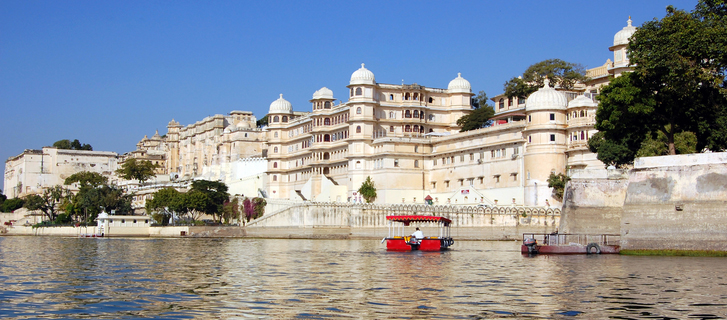
The City Palace in Udaipur is a blend of stern Rajput military architecture on the outside and lavish Mughal-inspired decorative art on the inside. Set on a hill overlooking Pichola Lake, the City Palace is a sprawling edifice made up of at least four separate, interconnecting palaces, built over a period of nearly three centuries. The entire palace is oriented to face the east. The earliest parts of the City Palace are reminiscent of the architectural style of Chittorgarh, but subsequent additions show an interesting evolution of style, although this is sometimes disguised by later remodeling. You enter the palace through two great gates, Bari Pol and Tripolia Pol, and carved torana archways. The maharajas used to be weighed here, and their equivalent in gold was then distributed to charity. Through Ganesh Deori, dedicated to the god of fortune, with its kitschy Japanese tiles, you come to Raj Angan, built in 1559, the oldest part of the palace. Legend says this was the very spot where Rana Udai Singh II met the sage who suggested this local for his new capital, and that the first thing he built was the Dhuni Mata Temple you see here.
Climbing a flight of steep steps you come to Bari Mahal, a delightful garden, nearly 90 feet above ground. Around the garden is a marble courtyard with a square, central pool and fluted columns, reminiscent of the Mughal style. This was once a royal playground. Old miniature paintings portray the maharajas at play with the ladies of their court, sprinkling them with colored water during Holi. Looking down from here you can see the courtyard below, where Udaipur’s great elephant fights were once staged. Beyond this lies Dilkhush Mahal (Palace of Joy), originally built in the 1620s, with two splendid chambers, Kanch ki Burj and Chitran ki Burj. Kanch ki Burj is a 19th century Sheesh Mahal, with elaborate gray and red mirror-work walls and ceilings, set off by a carved ivory door. Chitran ki Burj is a little 18th century masterpiece, its walls covered with frescos of hunting scenes, festivals and court life in princely Udaipur.
Next you see the 18th century Chini Chitrashala (Porcelain Painted Gallery), with its striking blue Dutch inlaid tile work, and amusing European influence that suddenly appears to compete with the Rajput and Mughal styles of the rest of the palace. Moti Mahal (Pearl Palace) is another Sheesh Mahal in the City Palace. Its walls are decorated with plates of mirror-work and colored glass, creating a magical interplay of reflections. Beside it is Bhim Vilas, a small prayer room with fine murals depicting episodes from the life of Lord Krishna and Radha. Across the courtyard is Priyatam Niwas, the simple apartment where Maharaja Bhopal Singh used to live, right up until 1955. You can see some of his memorabilia here, including his wheelchair. Below these apartments is the grand Mor Chowk (Peacock Courtyard), its wall covered with a dramatic mosaic relief of dancing peacocks. Nearby is another well-known feature of the palace, Surya Gokhra (Sun Window), from where the maharajas would appear to the people during times of misfortune.
Manak Mahal (Ruby Palace) was built in 1620 as a dining room. It has walls inlaid with ornate mirror-work and colored glass. Inside it are the amusing mosaics of 18th century Englishmen being served wine by Rajput maidens. The City Palace museum contains a wonderful collection of old Rajput weaponry. One of the weapons looks like an ordinary sword, but is actually a traditional two-swords-in-one scabbard (which you would draw simultaneously so you have a sword in each hand). Somewhat more dangerous looks are the old maces and an arrow with a large crescent-shaped arrowhead (allowing you to aim for the throat and slice off your victim’s head). Other historic pieces include Maharaja Pratap’s suit of armor and the war bugle and drums of Rana Sanga.
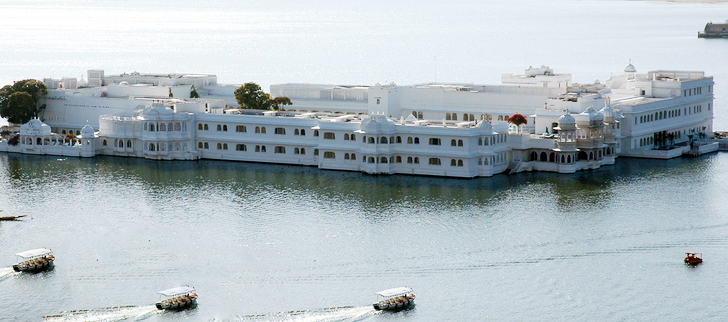
Perhaps the best way to see Udaipur is by boat on Pichola Lake, preferably at sunset, sailing past its picturesque ghats and palaces. Pichola Lake was originally created in the 15th century by a Banjara grain merchant, who built a small dam here in order to allow his grain carts to cross over during the monsoon. As you sail toward the north of the city, you pass slowly by its various sights: first, the old hillside hunting box of the maharajas and the remnants of the old fortified walls, the City Palace, with its high towers and turrets; the lakeside havelis of the old city, with their cupola balconies reflected in the waters of the lake, and the high, triple-arched Gangaur Ghat where women bathe and was their clothes and where the colorful Ganguar festival is celebrated each year in spring. Finally, past the lakeside temples, you come to the island palaces of jag Niwas and Jag Mandir.
Chittorgarh, the awe-inspiring hill fort built on a massive rock, lies 72 miles northeast of Udaipur. It was said that this fort was the key to all of Rajputana, and any conqueror would have to gain control of it first. It is considered by many to be the finest medieval Hindu fort in existence. But more than that, it is cloaked in legends of valor, chivalry and glorious death and occupies a preeminent position in the Rajput psyche.
Chittorgarh was built in the 8th century by Bappa Rawal, the first of the great Sisodia rulers. Between then and 1567 it fell victim to three sieges, which resulted bloody battles that saw the defenders eventually defeated by invaders from Afghanistan. Rather than face slavery at the hands of their captors, the women of the royal families committed Jauhar, a Rajput tradition where the defeated self-immolate rather than face dishonor.
The ascent to the Chittorgarh Fort is by a steep, winding road, defended by seven fortified gateways. Past the Chittorgarh Fort wall is the oldest palace of Chittorgarh, Rana Kumbha’s palace, with its beautiful series of canopied balconies and a stepped outer wall. Opposite this palace lies Kunwar Pade ka Mahal (Crown Prince’s Palace), a wonderful example of early Rajput architecture. Just beyond lies the imposing temple of Vra-ji, built by Rana Kumbha, and, nearby, the temple of Mirabi, the celebrated 16th-century poet-saint.
The real architectural masterpiece at Chittorgarh, however, is Rana Kumbha’s great Vijaystambha (Tower of Victory), built in a Jain revivalist style. It has been restored subsequently, but if you look at the upper stories, you can see the splendidly carved original panels, depicting a variety of Hindu gods and goddesses as well as scenes from the Hindu epic the Ramayana. As you walk south from the Tower of Victory, you come to the Mahasati, the terrace where the maharajas were cremated. Just beyond this lies Gomukh, a large tank, fed by a perennial spring through a rock carved with the face of a cow.
South of the Gomukh tank are the ruins of a row of great mansions, including those of the heroes who defended Chittorgarh-Patta and Jaimal. These two palaces were among the last of the monuments to be built in the fort before its destruction in 1567. Patta’s palace echoes the style of the palace of Rana Kumbha and Kunwar Pade ka Mahal, with a stepped wall and rich decorations. A close look reveals the ornamented blue tiles that once adorned many of the buildings here. Jaimal’s palace, on the other hand, is solid and austere, but displays the perfect symmetry of plan that can be traced back to even the oldest Rajput palaces. Nearby is the Bundi Chief’s palace, with its beautiful old pool, lined with bathing terraces, and beyond it lie the ruins of Chittorgarh’s old Pearl Market.
Toward the south end of the Chittorgarh Fort is Kalika Mata Temple, originally dedicated to Surya, the sun god. It dates back to the 8th century, making it the oldest structure in the fort. Still further south, beyond Chonda’s Palace, lies the palace of Rani Padmini. According to legend, she is said to have been a Sri Lankan princess, so fair and delicate that when she drank water, you could see it pass through her throat! The original palace was a beautiful water palace, a forerunner of the later Jag Mandir and Jag Niwas in Udaipur.
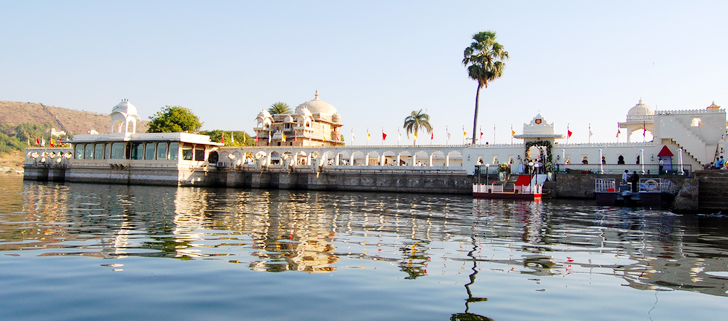
This older water palace, built in 1620 by Karan Singh, played an important role in Udaipur’s history. The Mughal prince, Khurram, exiled by his father, Emperor Jahangir, chose to seek refuge here. Jag Mandir owes its name to Jagat Singh, Khurram’s some, who was announced as the new Emperor Shah Jahan upon his father’s death in 1627, and transformed the palace quite considerably. His close relationship with the Mewar led to an important new era of peace, prosperity and architectural renaissance in Udaipur. The island has some striking carvings including a row of elephants that look like guarding the island. The exquisitely carved chatri in grey and blue stone also attracts the visitors.
Read more about Jag Mandir on Wikipedia.
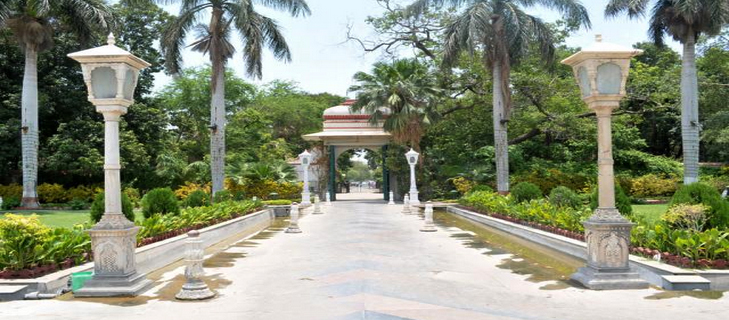
These beautiful gardens, Saheliyon Ki Bari (Gardens of the Maids of Honor), were laid out in the mid-18th century for a retinue of 48 young ladies-in-waiting who were sent to Udaipur as part of a princess’s dowry. The gardens have beautiful lawns, lotus pools, marble pavilions and marble elephant-shaped fountains. Once the site for royal picnics, the gardens are now a public park.
High on a hilltop just outside of Udaipur lies the dramatic 18th century palace, Sajjangargh, also called the Monsoon Palace, with a breathtaking view of the Mewar countryside. On a clear day you can see the fortress of Chittorgarh Fort. Originally intended to be a towering five-story astronomical center, it was later abandoned and used as a monsoon palace and hunting lodge. Today the Monsoon Palace is famous for its fantastic views of Udaipur. The drive up to the palace is through a small wildlife sanctuary, although sightings are uncommon. At night the palace is lit pink and green. Interestingly, the palace was used in the James Bond film Octopussy as the residence of Kamal Khan, an exiled Afghan prince.
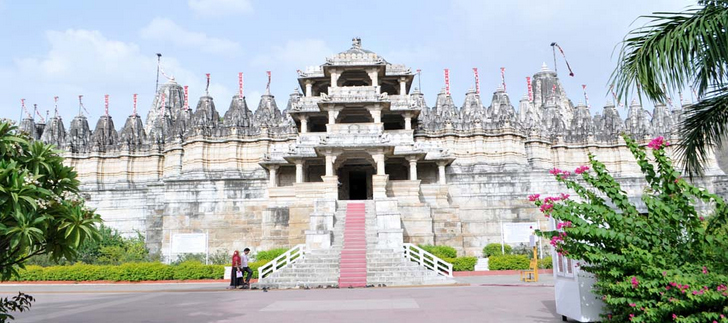
You may want to tour the famous 15th Century marble temple that is still an active place of worship. Although it is a 2.5 hour to 3 hour drive (each way) from Udaipur, most tourists visiting Udaipur devote a day to this excursion. Part of the attraction is the great drive through the hills and rural communities.
Deep in the forest lies the huge 15th-century Adinathi Temple at Ranakpur. It is the largest and most complex Jain temple in India, with 29 halls covering 4,320 square yards. Holding up its domes and spires are 420 ornately carved pillars. The construction of the main shrine took 50 years. The temple is one of the five great holy places of the Jain sect. Dedicated to the first tirthankara, Adinatha, it has 29 rooms supported by more than 1,400 interior pillars. It is so complex in form and overwhelming in scale that at first it leaves you quite bewildered. But, as you walk though its chambers, the pattern gradually emerges. It is designed in a cruciform plan, with four separate entrances, one on each side. Each of these leads, through a series of columned halls, to the central court and cruciform with its four faced Adinatha image. The temple is enclosed on all four sides by rows of chapels (86 in all), and is topped by 20 domes and five spires.
What makes the Adinatha Temple truly remarkable, of course, is the fact that all these grand architectural elements are completely covered with carvings, so profuse and so intricate that they resemble lace-work, rather than stone-carving. The ceilings are decorated with geometric patterns and scrollery; the domes are embellished with ornate concentric friezes and descending pendants; the brackets supporting the domes are designed with dancing goddesses. And when you study the richly carved pillars, you will realize that each one of them is carved with a different pattern from the rest. Look out also for one of the columns facing the sanctum, on which there is a small panel depicting a man with his hands joined. This is supposed to be Dharna Sah, the man who built this temple, while the figure next to him is Depa, his sculptor and architect. Another remarkable thing about the temple is the wonderful play of shadow and light, as the sun’s rays shift through the day, changing the pillars’ colors from gold to pale blue.
There are two other temples nearby, a 15th century Jain Parshvanatha temple, remarkable especially for its ornately pierced stone windows, and another 15th-century Hindu Surya temple.
Just south of the City Palace is Shiv Niwas and Fateh Prakash. Both were originally intended to be guest houses for the personal guests of the maharajas, but have now been turned into hotels. The smaller Fateh Prakash has some of the most exquisite Mewar miniature paintings from the Maharaja’s private collections. Fateh Prakash Palace is also home to a breathtaking collection of crystals. The crystal items include tables, sofa sets, dining tables, dressers, fountains and even beds besides a whole array of washing bowls, decanters and perfume bottles. There is also an exquisite jewel studded carpet.

